We're flying without wing flaps and without a pilot

The revolutionary model plane has been developed as part of a £6.2m programme, involving engineers from the University of Leicester, funded jointly by the Engineering and Physical Sciences Research Council and BAE Systems.
The five-year programme is called FLAVIIR - flapless air vehicle integrated industrial research - and involves teams from Leicester, Liverpool, Nottingham, Southampton, Swansea, Warwick, York and London. Manchester University's Goldstein Aeronautical Research Laboratory developed the model aircraft and the programme is managed by Cranfield University.
"The overall programme is aimed at developing new technologies for future generation uninhabited air vehicles, so called UAVs," said Professor Ian Postlethwaite, Pro-Vice-Chancellor and Professor of Engineering at Leicester.
"The team involves experts from around the UK in Aerodynamics, Control Systems, Electromagnetics, Manufacturing, Materials and Structures, and Numerical Simulation. The results from the different groups will be brought together in a single flying demonstrator in about 2009. The concept of a flapless vehicle, using fluidic thrust vectoring (where direction is changed with a secondary air flow) and air jets, is one important area of investigation. Another is the replacement of the pilot by sophisticated software that can autonomously fly the vehicle without collisions in what might be dangerous or remote environments." This is the contribution of the Leicester researchers.
Professor Postlethwaite and Dr Da-Wei Gu, working with Research Assistants Sarah Blaney, Kannan Natesan and Yoonsoo Kim and Research Students Ihab Abou Rayan, Jianchi Chen and Samir Hassoun from the Control group at Leicester, are involved in increasing the levels of autonomy and performance in UAVs through research on co-ordinated control, integrated control and condition monitoring.
Over the past year, the Leicester team has developed a software package for the flight path planning task. The package incorporates several planning methods and is able to run in real-time and deal with uncertain situations.
Algorithms for co-ordinated mission task planning involving several UAVs are currently under development. Some initial robust control systems have been designed for the demonstrator model and control schemes, which explore FTV (fluidic thrust vectoring) and CC (circulation control – which replaces conventional flaps by blowing air from the trailing edge of the wing) actuators will be a major development. A health management/condition monitoring system is also planned.
In addition, the Leicester team will explore the potential of multiple sensors (sensor arrays) distributed across an airframe to provide virtual air data for use in the health monitoring and improved control of future UAVs.
Another key project will be developing fault detection mechanisms for use in a fault tolerant flight control system, which can automatically adapt for failures sustained during a mission thereby maintaining adequate flight performance and stability.
Source: University of Leicester















